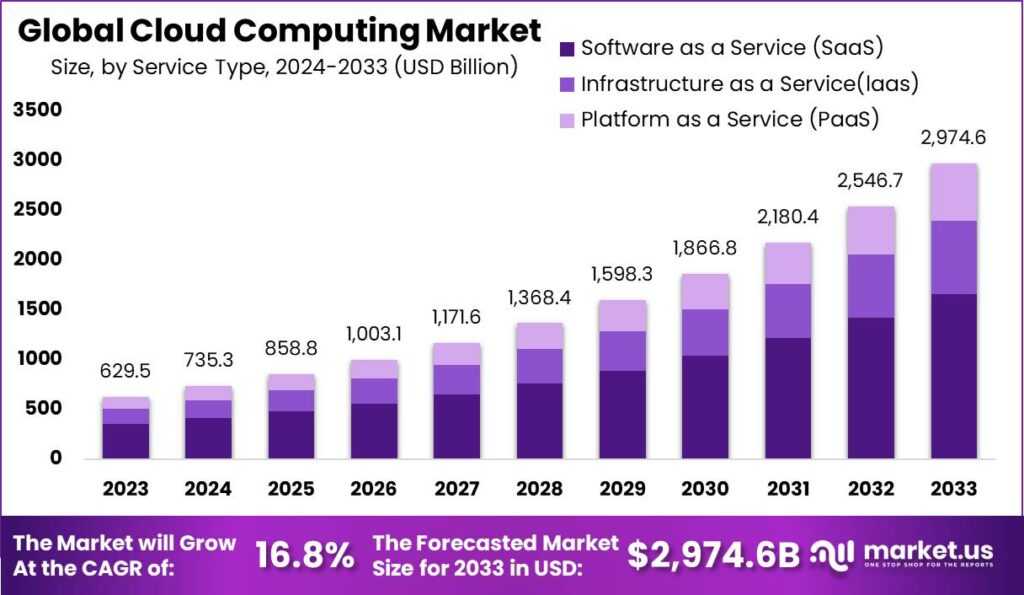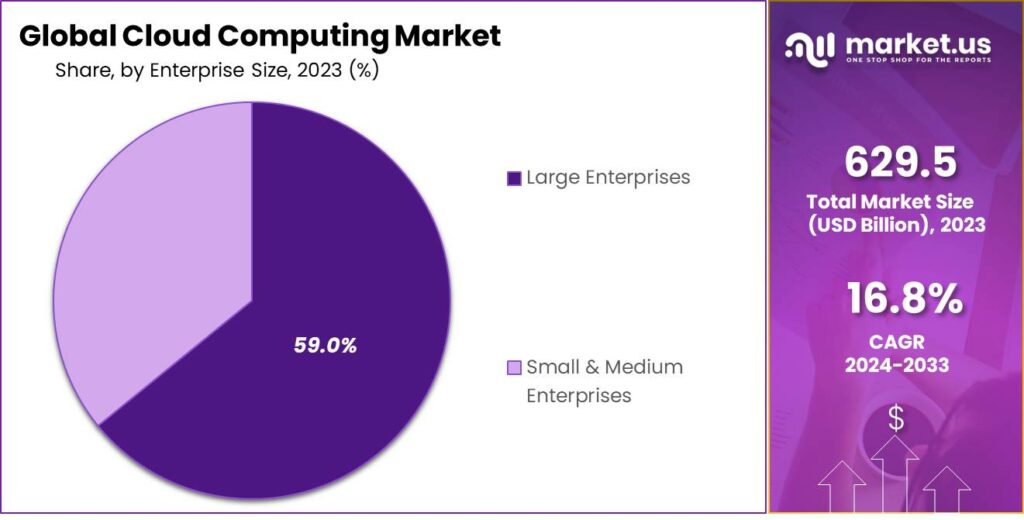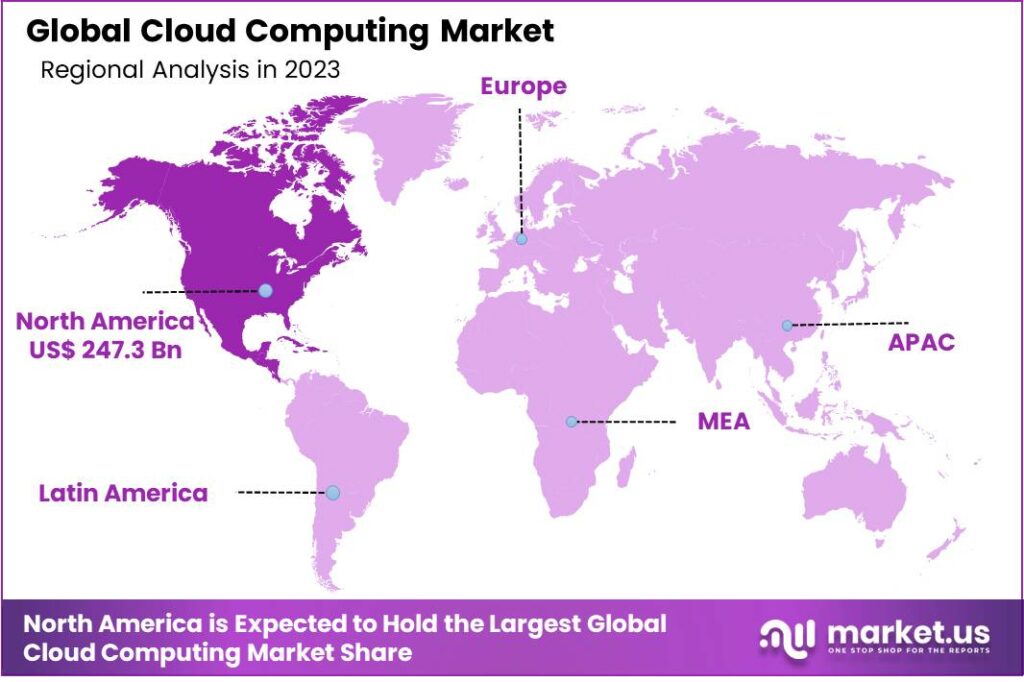Global Cloud Computing Market By Service Type (Software as a Service (SaaS), Infrastructure as a Service(laas), and Platform as a Service (PaaS)), By Deployment Mode (Hybrid Cloud, Private Cloud, and Public Cloud), By Enterprise Size (Small & Medium Enterprises and Large Enterprises), By End-Use Industry, By Region and Companies – Industry Segment Outlook, Market Assessment, Competition Scenario, Trends, and Forecast 2024-2033
- Published date: Jan. 2024
- Report ID: 32302
- Number of Pages: 296
- Format:
- keyboard_arrow_up
Quick Navigation
- Report Overview
- Analyst Viewpoint
- Key Takeaways
- Service Type Analysis
- Deployment Mode Analysis
- Enterprise Size Analysis
- End-Use Industry Analysis
- Driving Factor
- Restraining Factor
- Growth Opportunity
- Latest Trends
- Key Market Segments
- Geopolitical and Recession Impact Analysis
- Regional Analysis
- Market Share and Key Player Analysis
- Recent Developments
- Report Scope
Report Overview
The Global Cloud Computing Market size is expected to be worth around USD 2,974.6 Billion by 2033 from USD 629.5 Billion in 2023, growing at a CAGR of 16.8% during the forecast period from 2024 to 2033.
Cloud Computing refers to the delivery of computing services, including storage, processing power, software, and other resources, over the internet. Instead of relying on local servers or personal computers, cloud computing enables users to access and utilize these services remotely through a network of servers hosted in data centers. The cloud computing model offers scalability, flexibility, cost-effectiveness, and ease of access to computing resources, making it increasingly popular among individuals and organizations. It eliminates the need for on-premises infrastructure and provides on-demand access to a wide range of computing resources, enabling users to efficiently manage and scale their IT operations.
The Cloud Computing Market refers to the industry that offers cloud computing services and solutions to individuals, businesses, and other organizations. This market includes cloud service providers, cloud infrastructure vendors, software vendors, and other stakeholders involved in delivering cloud-based services. The market has witnessed significant growth in recent years, driven by the increasing demand for scalable, flexible, and cost-effective computing solutions.

Organizations across various industries are adopting cloud computing to streamline their operations, enhance collaboration, and reduce IT infrastructure costs. The market offers a wide range of services, including storage, computing power, networking, databases, analytics, and software applications, catering to the diverse needs of users.
Cloud computing providers compete based on factors such as reliability, performance, security, pricing models, and the breadth of services offered. As businesses continue to embrace digital transformation and leverage cloud computing for their IT needs, the Cloud Computing Market is expected to witness sustained growth in the foreseeable future. During May 2023, Amazon Web Services, the cloud computing division of Amazon, outlined its strategic initiative to invest USD 12.7 billion in cloud infrastructure within India by the year 2030.
Analyst Viewpoint
One of the primary driving factors is the cost-effectiveness of cloud computing. With the pay-as-you-go pricing model, organizations can optimize their IT expenditure by paying only for the resources they use. This eliminates the need for large upfront investments in hardware and software, making cloud computing an attractive option, particularly for small and medium-sized businesses. The cost savings, coupled with the ability to scale resources as needed, provide organizations with a competitive edge in the market.
In May 2023, IBM introduced the IBM Hybrid Cloud Mesh, a Software as a Service (SaaS) solution meticulously designed to empower enterprises with seamless access to their hybrid multi-cloud infrastructure. Fueled by the concept of “Application-Centric Connectivity,” IBM Hybrid Cloud Mesh is structured to streamline the automation of processes, management tasks, and observability of application connectivity, providing modern enterprises with the means to efficiently operate their infrastructure seamlessly across hybrid multi-cloud and diverse environments.
Furthermore, the ongoing digital transformation initiatives present a significant opportunity for the Cloud Computing Market. Businesses are increasingly adopting cloud-based solutions to modernize their IT infrastructure, enhance collaboration, and support innovation. Cloud computing enables seamless integration of applications and services, empowering organizations to drive efficiency, productivity, and innovation across their operations. As more industries embrace digital transformation, the demand for cloud computing services is expected to grow significantly.
Key Takeaways
- The Cloud Computing Market is expected to reach around USD 2,974.6 Billion by 2033, with a CAGR of 16.8% from USD 629.5 Billion in 2023.
- The Software as a Service (SaaS) segment dominated the market by holding a major revenue share of 55.8% in 2023
- The private cloud segment dominated the market by securing a greater revenue share of 43.1% in 2023.
- The large enterprises segment hold the largest revenue share of 59.0% in 2023.
- The BFSI segment dominated the market by obtaining a greater revenue share of 21.5% in 2023.
- North America dominated the Global Cloud Computing Market with a larger revenue share of 39.3% in 2023.
Service Type Analysis
On the basis of Service Type, the market for Cloud Computing is further categorized into Software as a Service (SaaS), Infrastructure as a Service(laas), and Platform as a Service (PaaS). Among these service type segments, the Software as a Service (SaaS) segment dominated the market by holding a major revenue share of 55.8% in 2023. The dominance of the Software as a Service (SaaS) segment in the market is attributed to its ease of use and accessibility. SaaS solutions offer businesses the advantage of accessing sophisticated applications without the need for complex software and hardware management.
This model eliminates the necessity for extensive installation processes and ongoing maintenance, significantly reducing IT overheads and resource allocation. The convenience of SaaS applications, which are accessible through web browsers, enables users to access services from anywhere, fostering flexibility and remote working capabilities. Additionally, the SaaS model offers scalability, allowing businesses to easily adjust their usage based on current needs without significant upfront costs. These factors make SaaS particularly appealing to a wide range of businesses, from small startups to large enterprises, driving its prominence in the cloud computing market.
Deployment Mode Analysis
Based on Deployment Mode, the market is divided into Hybrid Cloud, Private Cloud, and Public Cloud. Among these deployment mode segments, the private cloud segment dominated the market by securing a greater revenue share of 43.1% in 2023.
This dominance of the private cloud deployment mode in the market is largely due to its enhanced security and control features. Private clouds are dedicated to a single organization, providing a higher level of security and privacy compared to public clouds. This aspect is particularly crucial for businesses handling sensitive data, such as in the finance, healthcare, and government sectors.
Additionally, private clouds offer greater control over the IT environment, allowing organizations to customize their infrastructure to suit specific business needs and compliance requirements. This customization capability is a significant advantage for companies with complex or specialized IT needs. Furthermore, private clouds can offer better performance and reliability, as resources are not shared with other organizations. These benefits make private cloud an attractive option for businesses prioritizing security, control, and customization in their cloud computing solutions.
Enterprise Size Analysis
On the basis of Enterprise Size, the market is split into Small & Medium Enterprises and Large Enterprises. Among these enterprise size segments, the large enterprises segment hold the largest revenue share of 59.0% in 2023. This dominance of large enterprises segment is attributed to their significant resources and extensive requirements for robust IT infrastructure. Large enterprises often deal with massive volumes of data and complex business processes, necessitating a scalable and efficient computing solution.
Cloud computing offers such scalability, enabling these organizations to manage their extensive data and application needs more effectively. Furthermore, large enterprises possess the financial and technical resources to invest in comprehensive cloud solutions, including customized and advanced cloud services. Additionally, the strategic importance of digital transformation in large enterprises drives their higher adoption rates of cloud technologies, further strengthening their dominant role in the cloud computing market.

End-Use Industry Analysis
Based on End-Use Industry, the market is separated into IT & Telecommunications, BFSI, Retail & Consumer Goods, Energy & Utilities, Manufacturing, Government & Public Sector, Media & Entertainment, Healthcare, and Other End-Use Industries. From these end-use industries, the BFSI segment dominated the market by obtaining a greater revenue share of 21.5% in 2023. The Banking, Financial Services, and Insurance (BFSI) sector’s dominance in the market is largely driven by the industry’s need for highly secure, scalable, and efficient data management solutions.
The BFSI sector handles massive volumes of sensitive financial data, requiring robust systems for secure data storage, processing, and transmission. Cloud computing provides these capabilities, along with enhanced data analytics tools, which are essential for risk management, fraud detection, and customer analytics in this sector.
Moreover, the flexibility and scalability offered by cloud services align well with the dynamic nature of the BFSI industry, where market conditions and regulatory requirements frequently change. Cloud solutions enable BFSI institutions to swiftly adapt to these changes, ensuring compliance and maintaining competitive advantage. This combination of security, efficiency, and adaptability makes cloud computing an ideal option for the BFSI sector, leading to its significant market share.
Driving Factor
Increasing Demand for Cost-Effective IT Solutions
The Cloud Computing Market is being significantly driven by the growing need for cost-effective IT solutions. In an era where businesses are continually seeking to optimize operational costs, cloud computing presents an attractive option by reducing the need for substantial upfront capital investment in IT infrastructure. Cloud Computing offers a pay-as-you-go model, enabling businesses to scale their IT resources according to demand. This economic efficiency is particularly appealing to small and medium-sized enterprises (SMEs), which may not have the resources for large-scale IT investments.
Additionally, cloud computing eliminates the expenses associated with maintenance and upgrades of IT systems, as these responsibilities shift to cloud service providers. This factor not only contributes to cost savings but also allows businesses to focus more on their core activities, enhancing overall productivity. According to the Eurostat, 45.2% enterprises in the European Union bought cloud computing services in 2023, compared to 41.0% in 2021.
Restraining Factor
Data Security and Privacy Concerns
One of the primary restraining factor for the Global Cloud Computing Market is the concern surrounding data security and privacy. As businesses increasingly rely on cloud services to store and process sensitive information, the risk of data breaches and unauthorized access becomes a critical issue. Despite advancements in cybersecurity, incidents of data leaks and cyber-attacks persist, making potential clients doubtful in adopting cloud solutions.
Furthermore, compliance with various international data protection regulations, such as GDPR, adds to the complexity of using cloud services. Organizations must ensure that their cloud providers are compliant with these regulations, which can be a challenging and resource-intensive process. This concern is particularly noticeable in industries that handle highly sensitive data, such as healthcare and finance, where the implications of a data breach are substantial.
Growth Opportunity
Integration with Advanced Technologies
The integration of cloud computing with advanced technologies such as artificial intelligence (AI), machine learning (ML), and the internet of things (IoT) present a significant opportunity for the market. Cloud platforms provide the necessary infrastructure and computational power to effectively deploy these technologies, enabling businesses to harness their full potential.
For instance, AI and ML can be used to analyze vast amounts of data stored on the cloud, providing valuable insights and enhancing decision-making processes. Similarly, IoT devices generate large quantities of data that can be stored, processed, and analyzed in the cloud. This collaboration between cloud computing and advanced technologies is likely to upshot innovation, create new use cases, and drive further market growth.
Latest Trends
Increasing Adoption of Hybrid Cloud Solutions
An important trend in the Global Cloud Computing Market is the increasing adoption of hybrid cloud solutions. This approach combines the flexibility of public cloud services with the control and security of private cloud infrastructure, offering businesses a balanced and efficient computing environment.
Hybrid clouds are gaining importance as they provide the agility to move applications and data between different cloud environments as needed, addressing both compliance requirements and workload demands. This trend is mainly relevant for organizations that handle sensitive data or operate in heavily regulated industries, as it allows them to benefit from the scalability of the cloud while maintaining critical data on-premises. The rising demand for hybrid cloud deployment models is driving innovation and investments, making it an important factor for the market’s evolution.
Key Market Segments
Service Type
- Software as a Service (SaaS)
- Infrastructure as a Service(laas)
- Platform as a Service (PaaS)
Deployment Mode
- Hybrid Cloud
- Private Cloud
- Public Cloud
Enterprise Size
- Small & Medium Enterprises
- Large Enterprises
End-Use Industry
- IT & Telecommunications
- BFSI
- Retail & Consumer Goods
- Energy & Utilities
- Manufacturing
- Government & Public Sector
- Media & Entertainment
- Healthcare
- Other End-Use Industries
Geopolitical and Recession Impact Analysis
Geopolitical Impact Analysis:
Geopolitical tensions and policy shifts significantly impact the Global Cloud Computing Market. Regulations and data security laws emerging from these tensions compel cloud service providers to adapt to diverse national standards, affecting market entry strategies and operational models. For instance, policies mandating local data storage can lead to increased costs for providers needing to establish regional data centers. Moreover, geopolitical conflicts can disrupt global supply chains, affecting the availability and cost of hardware essential for cloud infrastructure. Such dynamics can lead to market fragmentation and influence investment decisions, potentially limiting the market’s growth in certain regions while creating opportunities in others.
Recession Impact Analysis:
In times of economic downturn, the Cloud Computing Market exhibits a degree of elasticity, primarily due to its cost-efficiency and scalability. During recessions, businesses often seek to reduce operational costs, and cloud services offer a viable solution by eliminating the need for significant capital investments in IT infrastructure. However, a prolonged recession could lead to reduced IT spending and delayed decision-making regarding new technology adoption, potentially slowing market growth. However, the inherent flexibility of cloud services, allowing businesses to scale resources according to their changing needs, positions cloud computing as a relatively stable sector even in challenging economic conditions.
Regional Analysis
North American Region Dominates the Market with a Major Revenue Share of 39.3%.
North America dominated the Global Cloud Computing Market with a larger revenue share of 39.3% in 2023. This dominance can be attributed to several factors. Firstly, the region boasts a well-established, advanced technological infrastructure, which is favorable for the widespread adoption and integration of cloud computing services.
The demand for Cloud Computing in North America reached US$ 247.3 billion in 2023, and there are optimistic projections for significant growth in the foreseeable future. Secondly, the presence of major cloud service providers, such as Amazon Web Services, Microsoft Azure, and Google Cloud Platform, headquartered in this region, drives innovation and market growth.
Furthermore, North American businesses, particularly in the United States and Canada, are typically early adopters of new technologies, including cloud computing, reflecting a market trend that is receptive to technological advancements and digital transformation. Additionally, the strong focus on research and development in the region, coupled with significant investment in IT sectors, further propels the growth and dominance of the Cloud Computing Market in North America.

Key Regions and Countries Covered in this Report
- North America
- The US
- Canada
- Europe
- Germany
- France
- The UK
- Spain
- Italy
- Russia
- Netherland
- Rest of Europe
- APAC
- China
- Japan
- South Korea
- India
- Australia
- New Zealand
- Singapore
- Thailand
- Vietnam
- Rest of APAC
- Latin America
- Brazil
- Mexico
- Rest of Latin America
- Middle East & Africa
- South Africa
- Saudi Arabia
- UAE
- Rest of MEA
The competitive landscape of the Global Cloud Computing Market is characterized by the dominance of major players such as Amazon Web Services (AWS), Microsoft Azure, and Google Cloud Platform, alongside a growing presence of other competitors like IBM Cloud and Oracle Cloud. The competition is further intensified by the entry of smaller, niche players who specialize in specific cloud services or cater to particular industries, thereby enhancing innovation and diversity in the market.
This dynamic environment is driven by continuous technological advancements, strategic partnerships, and mergers and acquisitions, as companies strive to expand their offerings and market reach. The intense competition necessitates companies to continuously innovate and improve their services, focusing on aspects like security, scalability, and cost-effectiveness to maintain and grow their market share.
Top Key Players in the Cloud Computing Market
- Adobe Inc.
- Google LLC
- Alibaba Group Holding Limited
- IBM Corporation
- Oracle Corporation
- Salesforce, Inc.
- Microsoft Corporation
- Cisco Systems, Inc.
- VMware LLC
- SAP SE
- Other Key Players
Recent Developments
- In September 2023 – Microsoft Corporation and Oracle Corporation expanded their collaboration to make Oracle Database Services available on Oracle Cloud Infrastructure within Microsoft Azure.
- In November 2023 – IBM Corporation partnered with Amazon Web Services, Inc. to introduce a new cloud database service, designed to enhance data management for AI-based workloads.
Report Scope
Report Features Description Market Value (2023) US$ 629.5 Bn Forecast Revenue (2033) US$ 2,974.6 Bn CAGR (2024-2033) 16.8% Base Year for Estimation 2023 Historic Period 2018-2022 Forecast Period 2024-2033 Report Coverage Revenue Forecast, Market Dynamics, COVID-19 Impact, Competitive Landscape, Recent Developments Segments Covered By Service Type (Software as a Service (SaaS), Infrastructure as a Service(laas), and Platform as a Service (PaaS)), By Deployment Mode (Hybrid Cloud, Private Cloud, and Public Cloud), By Enterprise Size (Small & Medium Enterprises and Large Enterprises), By End-Use Industry Regional Analysis North America – The U.S. & Canada; Europe – Germany, France, The UK, Spain, Italy, Russia, Netherlands & Rest of Europe; APAC- China, Japan, South Korea, India, Australia, New Zealand, Singapore, Thailand, Vietnam & Rest of APAC; Latin America- Brazil, Mexico & Rest of Latin America; Middle East & Africa- South Africa, Saudi Arabia, UAE & Rest of MEA Competitive Landscape Adobe Inc., Google LLC, Alibaba Group Holding Limited, IBM Corporation, Oracle Corporation, Salesforce Inc., Microsoft Corporation, Cisco Systems Inc., VMware LLC, SAP SE, Other Key Players Customization Scope Customization for segments, region/country-level will be provided. Moreover, additional customization can be done based on the requirements. Purchase Options We have three licenses to opt for: Single User License, Multi-User License (Up to 5 Users), Corporate Use License (Unlimited User and Printable PDF) Frequently Asked Questions (FAQ)
What is the market for cloud computing?The market for cloud computing is robust and continually expanding. It encompasses a wide range of services, including Infrastructure as a Service (IaaS), Platform as a Service (PaaS), and Software as a Service (SaaS). Organizations across various industries leverage cloud solutions to enhance scalability, flexibility, and cost efficiency in their IT operations.
How big is the cloud computing market?The Global Cloud Computing Market size is expected to be worth around USD 2,974.6 Billion by 2033 from USD 629.5 Billion in 2023, growing at a CAGR of 16.8% during the forecast period from 2024 to 2033.
Which region has the highest market share in the cloud computing market?North America dominated the Global Cloud Computing Market with a larger revenue share of 39.3% in 2023.
Who is the market leader in cloud computing?Adobe Inc., Google LLC, Alibaba Group Holding Limited, IBM Corporation, Oracle Corporation, Salesforce Inc., Microsoft Corporation, Cisco Systems Inc., VMware LLC, SAP SE, Other Key Players are the major companies operating in the Cloud Computing Market.

- Adobe Inc.
- Google LLC
- Alibaba Group Holding Limited
- IBM Corporation
- Oracle Corporation
- Salesforce, Inc.
- Microsoft Corporation Company Profile
- Cisco Systems, Inc.
- VMware LLC
- SAP SE Company Profile
- Other Key Players
- Nestlé S.A Company Profile
- settingsSettings
Our Clients
| Single User $4,599 $3,499 USD / per unit save 24% | Multi User $5,999 $4,299 USD / per unit save 28% | Corporate User $7,299 $4,999 USD / per unit save 32% | |
|---|---|---|---|
| e-Access | |||
| Report Library Access | |||
| Data Set (Excel) | |||
| Company Profile Library Access | |||
| Interactive Dashboard | |||
| Free Custumization | No | up to 10 hrs work | up to 30 hrs work |
| Accessibility | 1 User | 2-5 User | Unlimited |
| Analyst Support | up to 20 hrs | up to 40 hrs | up to 50 hrs |
| Benefit | Up to 20% off on next purchase | Up to 25% off on next purchase | Up to 30% off on next purchase |
| Buy Now ($ 3,499) | Buy Now ($ 4,299) | Buy Now ($ 4,999) |















